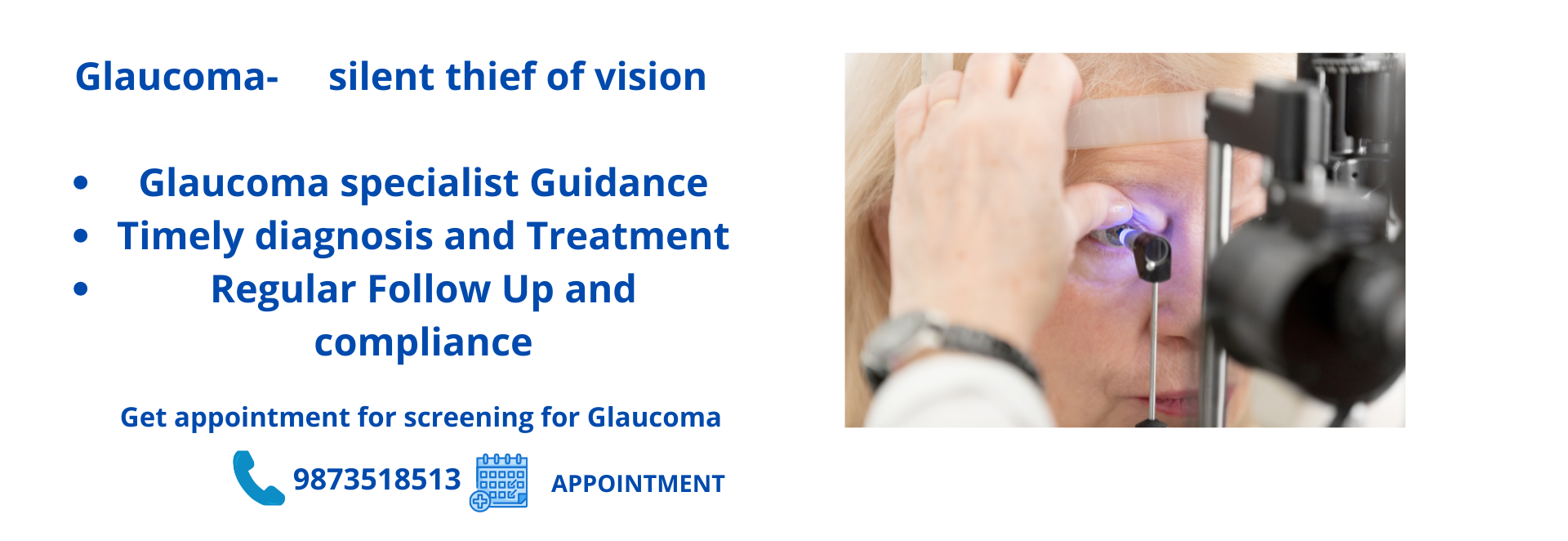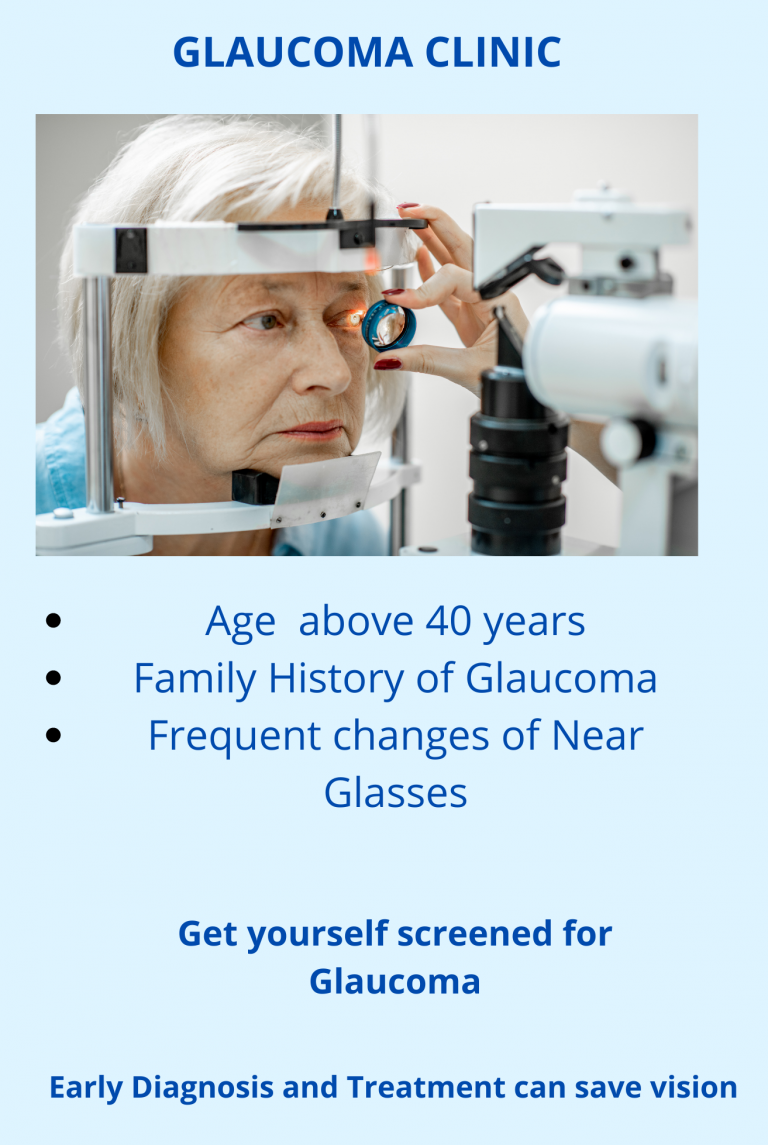
Vedanta Netralya clinics
We aim to care for our patients compassionately in a technologically cutting edge environment using the latest advances in clinical research.
GLAUCOMA -GENERAL AWARENESS
At a Glance:
Glaucoma is a group of eye diseases that can cause vision loss and blindness by damaging a nerve in the back of your eye called the optic nerve.
Glaucoma is the second most common cause of blindness worldwide. WHO has estimated that 4.5 million people over the age of 40 are blind due to glaucoma in world. In India, glaucoma is the leading cause of irreversible blindness with at least 12 million people affected and nearly 1.2 million people blind from the disease Symptoms may start so slowly that you may not notice them.
The only way to find out if you have glaucoma is to get a comprehensive eye exam. There are several types of treatment for glaucoma, including medicines (usually eye
drops), laser treatment, and surgery.
There’s no cure for glaucoma, but early treatment can often stop the damage and protect your vision.
INTRODUCTION
Glaucoma is commonly referred to as the silent thief of sight and is one of the leading causes of preventable blindness worldwide. It affects over million people around the world, most of whom don’t even know they have it. Glaucoma is a group of eye diseases characterized by damage to the optic nerve, the nerve that transmits visual information from the eye to the brain. In most cases, this nerve damage is produced by increased fluid pressure within the eye. This elevated pressure is caused by a backup of fluid in the eye. Over time, it causes damage to the optic nerve. Through early detection, diagnosis and treatment, you and your doctor can help to preserve your vision and often protect your eyes against serious vision loss.

RISK FACTORS
There are a few factors related to this disease which tend to put some people at greater risk:
People over the age of 40: While glaucoma can develop in younger patients, it occurs more frequently as we get older.
People who have a family history of glaucoma: Glaucoma appears to run in families. The tendency for developing glaucoma may be inherited. However, just because someone in your family has glaucoma does not mean that you will necessarily develop the disease.
People with abnormally high intraocular pressure (IOP): High IOP is the most important risk factor for glaucomatous damage.
People of African, Latino, and Asian descent: People with African and Latino ancestry have a greater tendency for developing primary open-angle glaucoma than do people of other races. People of Asian descent are more prone to develop angle-closure glaucoma and normal-tension glaucoma.
Additional risk factors include:
- Diabetes
- Myopia (nearsightedness) or Hyperopia (farsightedness)
- Regular, long-term steroid/cortisone use
- A previous eye injury
- A history of Sleep Apnea
- Extremely high or low blood pressure
The signs and symptoms of glaucoma vary depending on the type and stage of your condition.
For example:
Open-angle glaucoma
At first, open-angle glaucoma has no symptoms. It causes no pain. Vision stays normal.
Glaucoma can develop in one or both eyes.
Without treatment, people with glaucoma will slowly lose their peripheral (side) vision. As glaucoma remains untreated, people may miss objects to the side and out of the corner of their eye. They seem to be looking through a tunnel. Over time, straight-ahead (central) vision may decrease until no vision remains.
Acute angle-closure glaucoma
- Severe headache
- Eye pain
- Nausea and vomiting
- Blurred vision
- Halos around lights
- Eye redness
EARLY DETECTION
Early detection and treatment can reduce the risk of further vision loss and blindness. Because glaucoma often lacks early symptoms, early detection and treatment are key. That’s why regular eye exams are so important.If left untreated, glaucoma will eventually cause blindness.
Prevention
These self-care steps can help you detect glaucoma in its early stages, which is important in preventing vision loss or slowing its progress.
Get regular eye examinations. Regular comprehensive eye exams can help detect glaucoma in its early stages, before significant damage occurs. If you are 40 and have an additional risk factor listed above, get tested annually. Know your family and eye health history. Glaucoma tends to run in families. If you are at increased risk, you may need more frequent screening.
Exercise safely. Regular, moderate exercise may help prevent glaucoma by reducing eye pressure. Talk with your doctor about an appropriate exercise program.
Take prescribed eyedrops regularly. Glaucoma eyedrops can significantly reduce the risk that high eye pressure will progress to glaucoma. To be effective, eyedrops prescribed by your doctor need to be used regularly even if you have no symptoms.Wear eye protection. Serious eye injuries can lead to glaucoma. Wear eye protection when using power tools or playing high-speed racket sports in enclosed courts.
Diagnosis
Clinically if you are diagnosed to be a glaucoma suspect, your doctor will review your medical history and conduct a comprehensive eye examination. Confirmation of the disease is done using various tests as per the need of the patient, including:
- Measuring intraocular pressure (tonometry)
- Testing for optic nerve damage with a dilated eye examination and imaging tests(OCT RNFL) Checking for areas of vision loss (visual field test)
- Measuring corneal thickness (pachymetry)
- Inspecting the drainage angle (gonioscopy)
Treatment
The damage caused by glaucoma can’t be reversed. But treatment and regular checkups can help slow or prevent vision loss, especially if you catch the disease in its early stages.
Glaucoma is treated by lowering your eye pressure (intraocular pressure). Depending on your situation, your options may include prescription eyedrops, oral medications, laser treatment,surgery or a combination of any of these.








